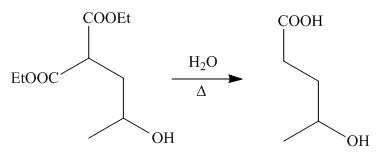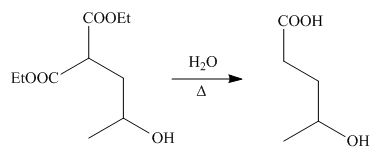
Concept explainers
(a)
Interpretation: The products formed by the reaction of
Concept introduction: Nucleophilic addition reaction is a type of organic reaction in which the nucleophile is added to the electrophilic site. The carbon atom in carbonyl compound acts as an electrophilic centre where a nucleophile attacks and gives an addition product.
Answer to Problem 23.47P
The product formed by the reaction of
Explanation of Solution
The given compound is,

Figure 1
The nucleophile

Figure 2
On the further treatment of

Figure 3
Hence, the product formed by the reaction of
The product formed by the reaction of
(b)
Interpretation: The products formed by the reaction of
Concept introduction: Nucleophilic addition reaction is a type of organic reaction in which the nucleophile is added to the electrophilic site. The carbon atom in carbonyl compound acts as an electrophilic centre where a nucleophile attacks and gives an addition product.
Answer to Problem 23.47P
The product formed by the reaction of
Explanation of Solution
The given compound is,

Figure 4
The nucleophile

Figure 5
On the further treatment of

Figure 6
Hence, the product formed by the reaction of
The product formed by the reaction of
(c)
Interpretation: The products formed by the reaction of
Concept introduction: Nucleophilic addition reaction is a type of organic reaction in which the nucleophile is added to the electrophilic site. The carbon atom in carbonyl compound acts as an electrophilic centre where a nucleophile attacks and gives an addition product.
Answer to Problem 23.47P
The product formed by the reaction of
Explanation of Solution
The given compound is,

Figure 7
The nucleophile

Figure 8
On the further treatment of

Figure 9
Hence, the product formed by the reaction of
The product formed by the reaction of
(d)
Interpretation: The product formed by the reaction of
Concept introduction: Nucleophilic addition reaction is a type of organic reaction in which the nucleophile is added to the electrophilic site. The carbon atom in carbonyl compound acts as an electrophilic centre where a nucleophile attacks and gives an addition product.
Answer to Problem 23.47P
The products formed by the reaction of
Explanation of Solution
The given compound is,

Figure 10
The nucleophile

Figure 11
On the further treatment of

Figure 12
Hence, the products formed by the reaction of
The products formed by the reaction of
Want to see more full solutions like this?
Chapter 23 Solutions
ORGANIC CHEMISTRY
- Draw the product of the following H action sequence. Ignore any inorganic byproducts formed. 1. (CH3CH2)2CuLi, THF 2. CH3Br Q Atoms, Bonds and Rings H Charges ㅁarrow_forwardPlease help me with this the problem is so confusingarrow_forward14 Question (1 point) Disiamylborane adds to a triple bond to give an alkenylborane. Upon oxidation with OH, H2O2, the alkenylborane will form an enol that tautomerizes to an aldehyde. In the first box below, draw the mechanism arrows for the reaction of disiamylborane with the alkyne, and in the last box draw the structure of the aldehyde. 4th attempt Feedback i > 3rd attempt OH, H2O2 i See Periodic Table See Hintarrow_forward
- answer with mechanisms and steps. handwritten please!arrow_forwardHello I need some help with Smartwork. For drawing structure B, I know the correct answer is CH₃B₂, but when I try to type it in, it keeps giving me CH₄BH₃ instead. Do you know how I should write it properly? Should I use a bond or something else?arrow_forwardTrue or false, chemistryarrow_forward
- answer thse questions with mechanisms and steps. handwritten please!arrow_forwardC app.aktiv.com Draw the product of the following reaction sequence. Ignore any inorganic byproducts formed. H O 1. (CH3CH2)2CuLi, THF 2. CH3Br Drawingarrow_forwardDraw the product of the following reaction sequence. Ignore any inorganic byproducts formed. H O 1. (CH3CH2)2CuLi, THF 2. CHзBr Drawingarrow_forward

 Organic ChemistryChemistryISBN:9781305580350Author:William H. Brown, Brent L. Iverson, Eric Anslyn, Christopher S. FootePublisher:Cengage Learning
Organic ChemistryChemistryISBN:9781305580350Author:William H. Brown, Brent L. Iverson, Eric Anslyn, Christopher S. FootePublisher:Cengage Learning

